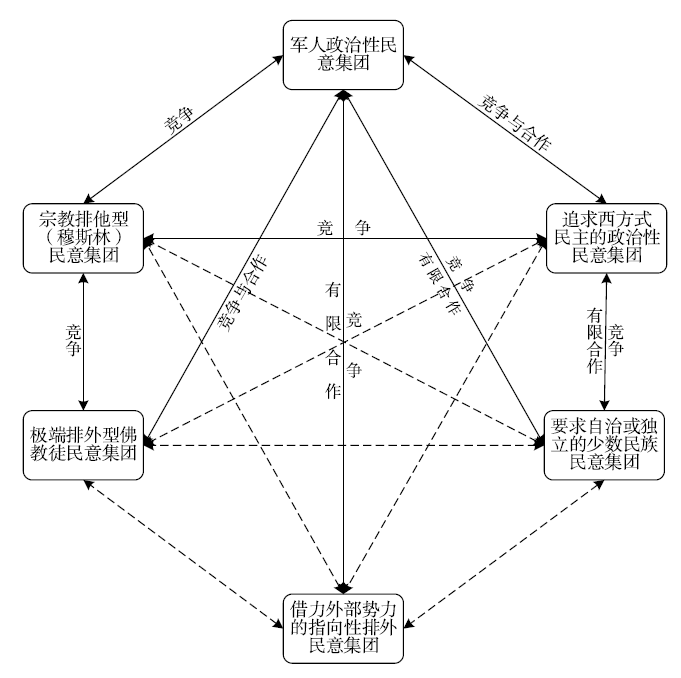

政治性民意集团及其利益博弈:缅甸国内长期冲突的一个分析视角
|
熊理然(1976—),男,教授,博士,博导,主要从事区域合作与地缘安全研究,(E-mail)xiongliran001@163.com; |
收稿日期: 2019-09-15
要求修回日期: 2019-11-18
网络出版日期: 2019-12-26
基金资助
国家自然科学基金项目(41561033,41861028)
国家社科基金重大项目(16ZDA041)
版权
Political Public Opinion Cliques and Its Interest Game: An Analytical Perspective of Long-term Internal Conflict in Myanma
Received date: 2019-09-15
Request revised date: 2019-11-18
Online published: 2019-12-26
Copyright
文章首先提出了一个国内政治性行为主体影响国家政局的分析框架,然后从“民意”“民意政治”“政治性民意”的视角,依据各民意集团的构成主体、利益诉求、行为方式等要素对缅甸国内的政治性民意集团进行梳理和划分,分析了缅甸政治性民意集团形成的时空环境,并对其形成的过程与机制进行探讨。。研究发现,在缅甸特殊的历史和地理环境背景下,形成了基于利益诉求而相互博弈的六大主要的政治性民意集团。各政治性民意集团或采取平等协商签订协议,或软硬兼施诱使妥协,或使用强力打击迫使接受等手段、方式进行权利博弈,成为缅甸国内主要的政治性行为主体。各政治性民意集团的借力博弈对缅甸政局产生了深远的影响,民意集团之间冲突的实质是其集团利益超越国家利益,这是缅甸国内长期冲突的主要致因。从“民意”“民意政治”的视域来研究一国内部的民主问题、民族问题、宗教问题和冲突问题是富有尝试性和探索性的,缅甸的实证研究也为研究特定国家的相关问题提供一个新的视野和参考借鉴。

熊理然 , 刘静 , 刘保强 , 蒋梅英 . 政治性民意集团及其利益博弈:缅甸国内长期冲突的一个分析视角[J]. 热带地理, 2019 , 39(6) : 812 -822 . DOI: 10.13284/j.cnki.rddl.003191
As an important neighboring country of China and an important node country along the Belt and Road Initiative, the internal political change in Myanmar will endanger the border security of China. As a result, furthering practical development of the community of shared interests as well as the community of a shared future between China and the surrounding countries will be influenced. First, in this study, we an analytical framework in which domestic political actors influence the state’s political situation. Then, from perspectives of “public opinion, “politics of public opinion,” and “political public opinion” this paper classifies the historical events of competition and cooperation among the political actors in Myanmar by analyzing historical documents. We divide the domestic political forces of Myanmar into six major political public opinion cliques according to features such as the composition subject and interests demand and behavior style. Then, we analyze the space-time environment of the political public opinion cliques forming process and discuss the process and mechanism of the formation of political public opinion cliques. By analyzing the behavior of political public opinion cliques, we consider that six major political public opinion cliques have been formed that are driven by individual interests and play chess with each other in the context of constitutional crisis and ethnic construction under the concepts of “one religion, one language, and one race.” Additionally, we consider that the geographical division of ethnic minorities and the Bamar are divided in the geographical environment of the spatial distribution caused by the topography of Myanmar territory. These public opinion cliques mainly include a military-political public opinion clique, a public opinion clique pursuing western-style democracy, an ethnic clique pursuing autonomy or independence, a public opinion clique with exclusivism by outside forces, an extremely xenophobic Buddhist public opinion clique, and a religious exclusionary (mostly Muslim) opinion clique. These political public opinion cliques have become the main political actors in Myanmar by signing agreements with equal consultation, inducing compromise with tactics, and forcing acceptance with powerful strikes. The essence of the conflict of political public opinion cliques is that their interests exceed national interests, and the game of political public opinion cliques has a far-reaching impact on the political situation of Myanmar, which is the main cause of the long-term conflict in Myanmar. The research on the issue of democracy and the national religious problems from the view of “public opinion” and “politics of public opinion” presented in this dissertation are tentative and explorative. In particular, the findings from this study are expected to offer a new perspective and reference for political public opinion events in neighboring countries such as political instability in Thailand and the questions about some people's opposition to China in the Philippines.


| [1] |
|
| [2] |
|
| [3] |
|
| [4] |
宫玉涛 . 2016. 近年来缅甸国内的民族冲突对我国西南边疆地区的影响. 西南民族大学学报(人文社科版), 37(2):37-43.
[
|
| [5] |
郭继光 . 2014. 缅甸政治转型过程中的宗教冲突探析. 东南亚研究,( 6):4-9.
[
|
| [6] |
|
| [7] |
胡志丁, 骆华松, 李灿松, 付磊, 熊理然 . 2015. 2009年后缅甸国内冲突的地缘政治学视角解读. 热带地理, 35(4):561-568.
[
|
| [8] |
焦佩 . 2014. 族群冲突对缅甸民主转型的影响. 东南亚研究,( 4):11-17.
[
|
| [9] |
|
| [10] |
|
| [11] |
|
| [12] |
|
| [13] |
|
| [14] |
李贵梅 . 2015. 缅甸日据时期“缅克冲突”探析. 东南亚研究,( 1):21-26.
[
|
| [15] |
[缅甸] 连·H·沙空 . 2012. 缅甸民族武装冲突的动力根源.乔实. 译. 国际资料信息,( 4):11-19.
[
|
| [16] |
[缅甸] 伍庆祥 . 2018. “罗兴伽”的污名化——缅甸“罗兴伽”问题的文化过程. 南洋问题研究,( 2):36-45.
[
|
| [17] |
|
| [18] |
戚凯 . 2017. 缅甸民族冲突与中缅能源合作:现状、影响与应对. 黑龙江民族丛刊,( 2):38-43.
[
|
| [19] |
|
| [20] |
田雪雪, 胡志丁, 王学文 . 2019. 当前缅北冲突与中缅边界管控研究. 世界地理研究, 28(2):114-123.
[
|
| [21] |
王天韵 . 2018. 缅甸民族宗教冲突的外溢效应与国际回应. 中央民族大学学报(哲学社会科学版), 45(2):167-176.
[
|
| [22] |
熊理然, 骆华松, 付磊, 胡志丁, 李灿松 . 2015. 缅北果敢冲突的时空演进及其对中国边境安全的直接影响——基于事件数据及实地调查的解读. 热带地理, 35(4):577-584.
[
|
| [23] |
闫德华 . 2014. 若开邦冲突对缅甸政治经济安全的影响. 南亚研究,(4): 32-46, 154.
[
|
| [24] |
阳举伟, 左娅 . 2018. 缅甸族群冲突与族群和解进程探究. 东南亚研究 (4): 61-86, 155.
[
|
| [25] |
于海利, 刘静, 胡志丁, 熊理然, 李灿松, 付磊 . 2015. 缅甸果敢难民涌入对中国边境地区的影响. 热带地理, 35(4):585-591.
[
|
| [26] |
章远 . 2016. 缅甸独立后的族际宗教冲突和治理困境. 东南亚研究,( 1):11-22.
[
|
/
| 〈 |
|
〉 |